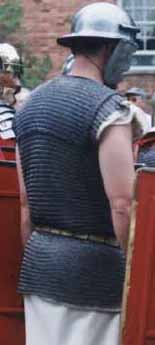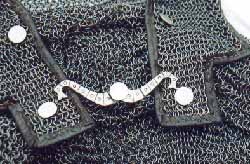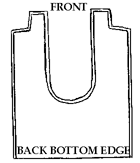LEGIO XX ONLINE HANDBOOK
LORICA HAMATA--MAIL
3/15/11
----------
*Home*Handbook Intro*Tunic*Caligae*Cloak*Belt*Helmets*Segmentata*Hamata*Squamata*Subarmalis*Scutum*Gladius*
*Pilum*Pugio*Packs*Mess
Gear*Tools*Crests*Drill*Leatherworking*Armoring*
----------
 |
Mail was the "standard"
armor
before the introduction of the lorica segmentata,
and it continued in use among auxiliaries
and
legionaries throughout the imperial period. It is not known what
the ratio of hamata to segmentata might have been in the mid-first
century
AD, but either is acceptable.
Mail was also worn by standard-bearers, musicians, and centurions,
and of course by auxiliary troops.
Roman mail was generally
made of
iron, with rings as small as 1/8" in diameter, in the common "4 in 1"
pattern.
Usually, half the rings were solid--either punched from sheet metal, or
cut from wire and welded shut--while the rest were riveted shut.
The solid rings were roughly square in cross-section, i.e., the
difference
between the ring's inner and outer diameter was the same not much
greater
than the thickness. The wire for the riveted rings could be round
(usually) or square. While it was long believed that some Roman
mail
rings may simply have been butted shut, closer analysis of surviving
fragments
has not revealed any definite proof of that. There is evidence
that
the rings could be tinned or even gilded!
Roman rings with an inside diameter of c. 5 mm and an outside
diameter of c. 7 mm were apparently very typical. An outside
diameter of 10 mm or 3/8" seems to have been about the maximum, but for
our purposes an outside diameter of about 1/2" will be accepted.
Steel wire of about 16 gauge is typical for reproductions, though
thinner is better particularly for smaller or riveted rings. PLEASE
DO NOT BUY BUTTED MAIL FOR LEGIO XX USE! Save
your money
for the better stuff--riveted mail is available from several suppliers. See the suggestions below,
and consult the Commander.
Note that wearing mail
does NOT mean that you are limited to wearing a Coolus helmet!
This is a modern stereotype, and any acceptable Imperial-Gallic or
Italic helmet is an option.
|
 |
While galvanization
protects
against rust, especially during construction, it should be removed when
the shirt is done, for a more authentic appearance (zinc galvanization
is NOT the same as tinning!). This can often be done by soaking
the
mail in vinegar for 12 to 24 hours--do this outside, as hydrogen gas
can
be given off. Rinse the mail VERY WELL immediately upon removing
it from the vinegar, dry it off as much as possible, and oil it against
rust. Battery acid has also been used, as well as
hydrochloric/muriatic
acids such as "ZAP" tile cleaner. Rolling the mail in a barrel of
sand should also work, though it will leave the mail very dirty.
 |
The typical
mailshirt is
sleeveless or has short sleeves (c.5"), and reaches to about
mid-thigh.
The shoulder doubling, shaped like a square-bottomed U (at right), was
probably backed by leather (c. 2-3 ounce), which is
folded
over the edges and stitched through. On most modern
reconstructions the doubling is attached to the body by a row of rings
along the back bottom edge, but two surviving Roman shirts from Britain
have small buckles riveted to the back, presumably to secure the
shoulder doubling.
Riveted to the center of the chest is a pair
of
S-shaped
hooks of iron or brass, which hook onto a button or stud on each
flap.
For auxiliary cavalry and some officers, the shoulder doubling has
wider flaps which drape over the shoulders. This
is apparently a Celtic variation, as shown here.
It could be more of a circular cape, attached around the neck opening,
but the evidence for this is shaky.
At some point in the later first century most auxiliaries began to wear
shortsleeved mailshirts without shoulder doublings, though the doubling
is still seen on legionaries on the Trajanic Adamklissi monument.
The zig-zagged edges seen on the mailshirts on Trajan's Column might be
only an artistic convention. |
 |
There does not seem to be
any direct
evidence that the Romans "tailored" their mail, adding or subtracting
rings
from certain rows to shape the shirt. Since mail naturally
conforms
to the body, any hamata will fit a number of different-sized people,
even
without tailoring.
The chest hooks were frequently
cast brass, but they were also sometimes made from sheet brass or
iron.
Studs were often cast as well, but can be made simply by riveting discs
in place, not tightly but with some extra length on the shaft of the
rivet.
Solid brass or pewter buttons have also been used, and some sort of
large-headed
nail might work.
You will need a subarmalis
to wear between your hamata and your tunic. Not only does this
keep
your tunic clean, but it has become clear that some fairly stiff
padding
and/or leather is essential to allow mail its full protective
potential.
When properly made and properly padded, mail has been shown to be a far
more effective defense than was once thought. It is extremely
difficult
to cut or break any of the rings under battlefield conditions, though
of
course it is possible to damage the wearer without actually cutting
through
the mail. The shoulder doubling may have been backed with leather
(or padding), which would have to be cut so that the flaps flair
outwards
in a slight curve as on the ancient
Greek linothorax (linen cuirass). This prevents them from
sticking
up strangely at the shoulders. (The mail itself can be cut
straight
because it flexes easily to the proper shape.)

|
Samples of
reproduction
mail. Those at top were
made by Erik D. Schmid.
The finer one on the left can be considered very typical of Roman mail,
with rings just under 7 mm in outside diameter. The riveted rings
are made from round-section wire but have been slightly flattened.
The sample at upper right was graciously donated by Arthur
Hendrick.
The
punched rings are about 7/16" outer diameter and 5/16" inner diameter,
and are about 1/16" thick. The riveted rings are made from iron
wire
of about 1 mm diameter. Erik points out that the rings are
too large to be typical, and their ends overlap
right-over-left while all the Roman samples he has seen overlap
left-over-right. We will still consider mail of this quality to
be very acceptable for our purposes!
Across the bottom is
butted mail made by Matthew Amt. The wire is 16 gauge, and the
rings are just under half an inch in outside diameter, c. 3/8" inside
diameter (the wire was coiled on a 5/16" diameter rod).
All the pieces are the
standard "4 in 1" pattern, also known
as International or European. Each ring is linked through 4
others,
2 above and 2 below, but never to one in its own horizontal row.
|
Thanks to Erik D. Schmid for
much
of the information on this page!
For a PDF file with DETAILED
analysis
of several original pieces of Roman-era mail, click here:
http://home.armourarchive.org/members/andersh/Reenactment/Joutij%e4rvi.pdf
For a brief article about a
complete
lorica hamata excavated in Britain, click here: http://www.armatura.connectfree.co.uk/arma/mail.htm
Photos of original pieces of
lorica hamata on the Roman Hideout site, http://www.romanhideout.com/armamentarium.asp,
and at the Online Collection of Roman Artifacts, http://www.roman-artifacts.com/.
Find-It Armory --http://www.finditarmory.com.
Great lorica hamata only $425!
Alternating rows of riveted and solid rings, 8mm inner diameter (c.
10mm outer diameter), proper shoulder doubling with leather edging, and
reasonable brass chest hooks. They also offer an even better
hamata with 6mm inner diameter rings for c. $800.
Get Dressed For Battle may be a
good source--their mail is reportedly quite good though we have not
seen it yet. Their Indian manufacturers, Indian
Handicrafts & Textiles Syndicate, assure us that they are producing
excellent mail with 6mm inner diameter rings. They also retail
through
Battle-Merchant in Germany, http://www.mittelalterwaffen.com/
, and may also sell direct from India: ashok
AT syndicate-group DOT com
The best reproduction mail
available
at the moment is custom-made by Erik D. Schmid,
though it is expensive. Unfortunately, he is not taking new
orders at the moment.
Deepeeka offers a
reasonably
properly-shaped hamata, apparently in a variety of ring sizes,
combinations,
and metals. The main complaint is that their rings are all
riveted,
rather than half riveted and half solid. The rings are also a tad
large, and the flattened ends are exaggerated. The chest hooks
could be
better, too. This may all be improved in the next few
months, but currently Find-It Armory and GDFB are better options.
Several other suppliers
sell medieval-style mailshirts with butted rings that might be modified
into a lorica hamata by using rings from the sleeves and possibly the
hem
to make the shoulder doubling. Riveted
shirts
would be harder to modify, though a few lines of butted rings where
joints
are necessary might not be very noticeable. And Forth Armory
sells
loose rings and rivets (and riveting tongs) for repairs and
adjustments.
(Beware of galvanized mail.)
Obviously, you can also make
your own mail!
Making Roman-Like Riveted Maille
http://www.mailleartisans.org/articles/articledisplay.cgi?key=12734:1x3kzp8f
Riveted Maille
http://www.ancient-warfare.org/index.php?option=com_kunena&func=view&catid=20&id=34435&Itemid=40
Butted mail is the simplest
type
of armor to make, requiring only wire and a few simple tools, though it
does take time! We are also trying to phase butted mail out
of
use in Legio XX, so if you are planning on being an active member you
should get riveted mail instead. Here is one of the
numerous websites which show
the process:
Butted Mail: A Mailmaker's Guide
http://homepage.ntlworld.com/trevor.barker/farisles/guilds/armour/mail.htm
----------
*Home*Handbook Intro*Tunic*Caligae*Cloak*Belt*Helmets*Segmentata*Hamata*Squamata*Subarmalis*Scutum*Gladius*
*Pilum*Pugio*Packs*Mess
Gear*Tools*Crests*Drill*Leatherworking*Armoring*
----------
*Home*Schedule*Handbook
*Auxiliaries *Civilian
Clothing *Cold-Weather Clothing *Signum*LINKS*SUPPLIERS*Bibliography
*
*ADLOCVTIO*Tent
and Camp *Roman Days*History*Names
*Advice
on Starting a Group *PHOTOGRAPHS*Bylaws
*Membership*




